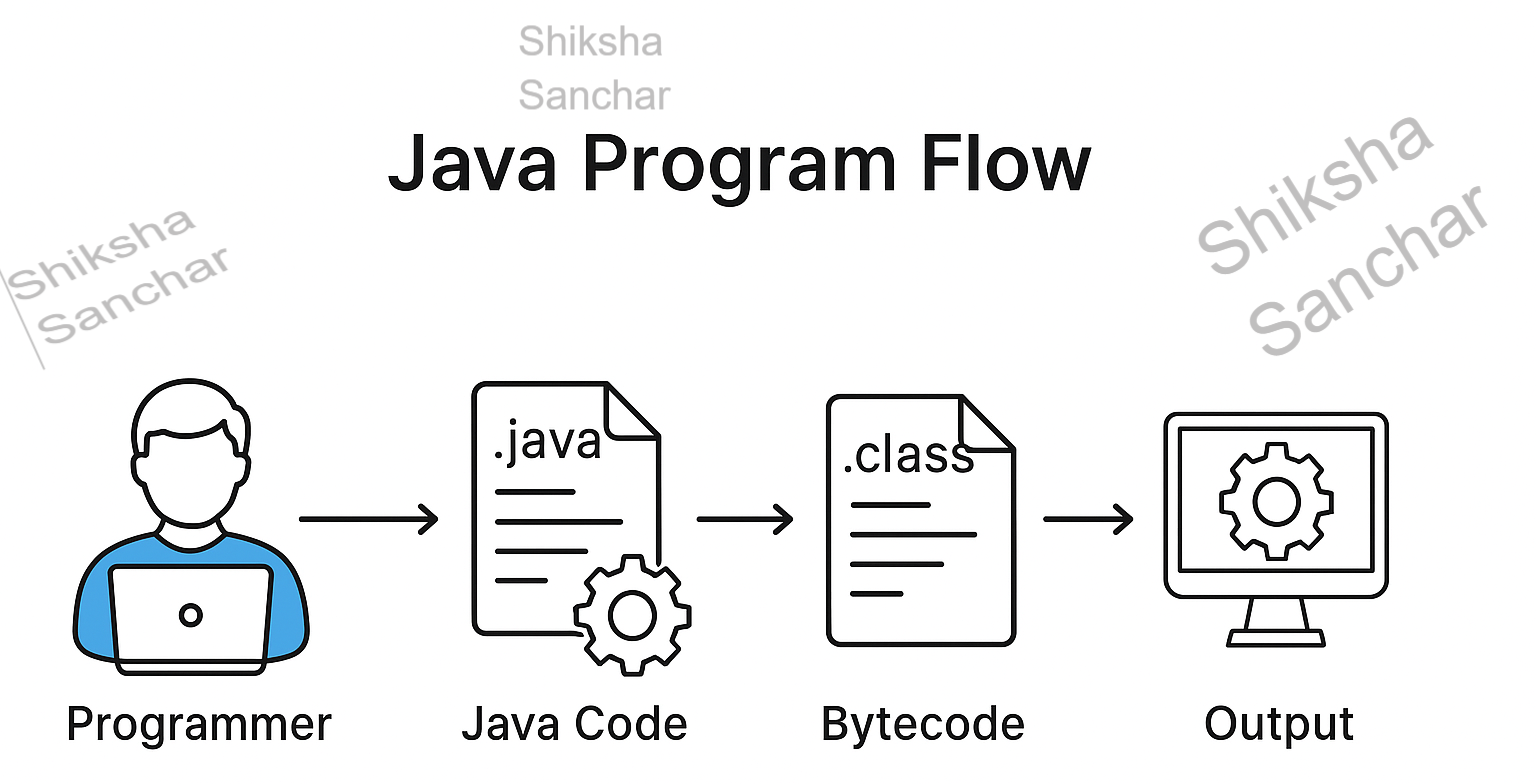Introduction to Java
Java was officially released in 1995 by Sun Microsystems, which was later acquired by Oracle Corporation. Java is a platform-independent and high-level programming language developed by James Gosling and his "Green" team.
Work Flow Diagram Representation of Java

The above diagram illustrates the basic flow of a Java program from writing code to getting output:
- Programmer: A programmer writes the
source code using a text editor or IDE. The file is saved with a
.javaextension. - Java Code: This source code contains the logic written in the Java programming language.
- Bytecode (.class): The
.javafile is compiled using thejavaccompiler, which converts it into platform-independent bytecode saved as a.classfile. - Output: The bytecode is executed by the Java Virtual Machine (JVM), which interprets or compiles it to machine code and produces the final output on the screen.
This process highlights Java's core concept: Write Once, Run Anywhere.
History of Java
In the early 1990s, as the internet was growing, there was a need for a platform-independent programming language. Most popular languages at the time, like C and C++, were platform dependent – meaning programs written in one system would not easily run on another.
To solve this problem, a team of engineers at a company called Sun Microsystems, based in California, USA, started working on a new language. This team was led by James Gosling and was known as the Green Team.
Interesting Fact:
Java was not originally made for the public. It began as part of an internal project called the Green Project, where the team was developing a smart device named Star7. This device was meant to control TVs and set-top boxes using sensors and a remote. For such embedded systems, they needed a programming language that was:
- Simple
- Secure
- Portable (able to run on different devices)
That’s how the idea of Java was born. Later, when they realized how powerful and flexible the language was, they decided to release it publicly — and it quickly became popular around the world.
How Java Got Its Name
Before choosing the final name "Java", the team came up with several name ideas:
- Oak : Inspired by an oak tree that stood just outside their office. This was actually the first name of the language! But it was already taken by another company, so they couldn’t use it.
- C++ ++ -- : A funny and clever way to show that this new language was a better and simpler version of C++. But of course, this was never a serious name choice — just an inside joke!
- Green : This name came from their project team name, the "Green Team". It was considered, but didn’t sound catchy enough.
- Java : They decided to name the language "Java", inspired by their favorite coffee.
Reason: The team used to drink a lot of coffee while working late hours on the project, and "Java" (a type of coffee) felt:
- Short
- Cool
- Easy to remember
- Unique!
And that’s how the name Java was born — thanks to a steaming cup of coffee!
Key Features Introduced by Sun Microsystems
- Platform Independent – Write once, run anywhere.
- Object-Oriented – Based on real-world objects.
- Free to Use – Anyone could use Java without paying.
- Open Source – Anyone could view and contribute to its code.
What Happened After Oracle Acquired Java?
- Before 2010:
Java was completely open-source, meaning anyone could use it and modify its code freely. - After 2010 (when Oracle acquired Java):
Some parts of Java became closed-source, especially for commercial use (businesses had to pay for support services). Oracle introduced commercial licenses for these services. - But, the core of Java remained
open-source:
OpenJDK, the open-source version of Java, is still available for free. Anyone can use and contribute to it. - Key Features Still the Same:
Java’s core features like platform independence, object-oriented programming, and security are the same in both OpenJDK and Oracle JDK.
Why Learn Java?
Java is a powerful and beginner-friendly language used worldwide. Here’s why students and developers love to learn it:
Chracteristics of Java
-
Platform Independence
Write once, run anywhere! Java runs on any OS without changes—great for cross-platform apps.
-
Used in Industry
Top companies like Google and Amazon use Java. Learning it means great job opportunities.
-
Big Community Support
Millions of Java users = lots of help, tutorials, and code examples online.
-
Beginner Friendly
Java is easy to read and understand, making it perfect for learning programming basics.
-
Android App Development
Java is the main language for Android apps. Learn it to build mobile applications.
-
Fast and Scalable
Java can handle small apps or big systems like e-commerce or banking software.
-
Secure
Java has strong built-in security, perfect for safe and reliable applications.